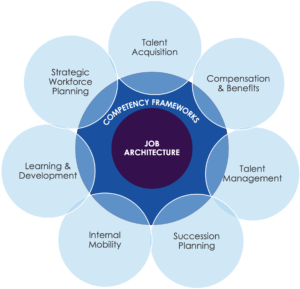Business repositories are dead, long live the job architecture !

It has been proven that having several decentralised tools makes it difficult to manage tasks efficiently on a daily basis. Xavier Le Page believes that this observation also applies to HR functions, who have to manage their business repositories using a common structure in order to make the most of their data. He thus mentions the need to adopt an ” architectural ” approach, even if it means creating a new role within HR teams: the HR Data Architect.
What is a job architecture, and why it should become the cornerstone of your skills management? Let’s find out.
From several repositories to a single architecture
When we take a serious look at the subject of business repositories in international groups, there is always one problem: there are often several business repositories that coexist for reasons of structural heritage (mergers and acquisitions of entities), governance (decentralised) or technology (different tools or databases). In this case, wouldn’t it be more efficient to have a single repository for the entire company?
To understand the value of this approach, we can start by looking at the practices of functions other than Human Resources. Can the Finance function be a good business partner at a global level without a single cost centre nomenclature? Not sure. Can the Supply Chain function be a good business partner without a taxonomy of materials or products entering and leaving the value chain? Probably not.
The point is not to say that employees should be managed like budget lines or spare parts, of course. What we are saying is that in order to professionally manage key company resources, a common structure is needed. We call this a business architecture.
Business architecture to break down silos
Apart from taking inspiration from the best practices of other functions, we can ask what is the point of a common business architecture. One of the great tragedies of the HR function is the loss of efficiency at the interfaces between the various centres of excellence, particularly between Strategic Workforce Planning and Learning, between Learning and Internal Mobility or between Talent Acquisition and Strategic Workforce Planning.
There is little chance of understanding each other in the absence of a common language. The human element is therefore used to compensate, with teams that counterbalance the structural shortcomings. However, at a time when tools are being put in place to ensure the coherence and fluidity of major employee management processes, this lack of a common language takes a very concrete form: the data is no good, because the architecture of the data itself is inconsistent.
If you have seen new job postings for Data Architects or Business Data Architects in your recruitment plans, then you should know that HR Data Architect will shortly be joining the list…
Architecture, a user guide
In theory, setting up a business architecture is useful and efficient, but what does it mean in practice? At Akoya, we are regularly requested to address this issue by large corporations as well as by fast-growing companies. Whether you are a blue chip or a unicorn, no one can escape the challenges of business architecture.
Large groups generally find that changes in HRIS provide an opportunity to (re)examine the issue of the inadequacies or inconsistencies of the reference systems that structured the data in the previous HRIS.
The Achilles’ heel of current architectures is that they are designed with a single use in mind, whereas they should be inherently versatile. An HR Data Architect, or those who take on this role, must therefore start by understanding the possible uses of the architecture and taking a look at the process owners before proceeding with the arbitrations necessary for any enterprise architecture subject (see the following diagram, listing all the functions to be included in a discussion on business architecture).

Business repositories are no longer enough: it is now necessary to build a business architecture and call on an HR Data Architect to do so. While the task may seem as immense as the one entrusted to Edifis in Asterix and Obelix, the architecture ultimately makes it possible to improve the usability of HR data and make the employee experience more fluid. So, when will the new job offer be ready?
Xavier Le Page
Partner
Skills of the future in the energy industry
What are the future strategic competencies in energy distribution?
Discover the caseDefining the critical skills of a leader in cosmetics
How can critical skills be defined in relation to strategic challenges?
Discover the caseEncouraging internal mobility within the R&D division
How to encourage internal mobility in the R&D business environment?
Discover the case